The dental industry is constantly changing and evolving. And while this may sound like a great thing, it can actually be difficult to keep up with all the changes, new procedures and materials. It’s important for dental professionals to stay informed and updated on these changes so they can provide their clients with the best quality care possible.
New products are introduced every year and it can be hard to keep up with the latest and greatest. Here is a technology update for dental products that are still making waves as we cross into the last quarter of the year.
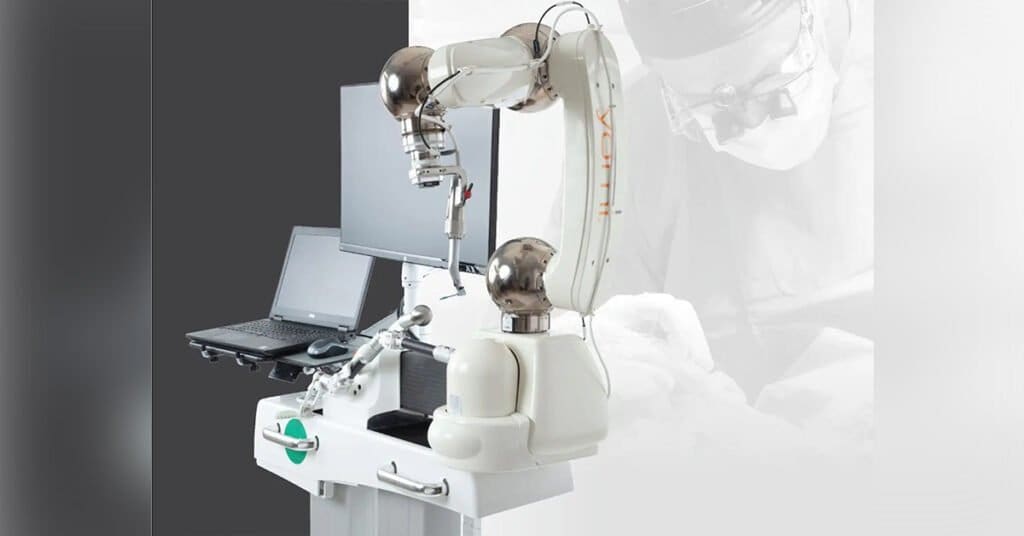
YomiPlan Go robotic workflow
YomiPlan Go works with the the larger YomiPlan suite of software and Yomi, a robotic surgical system that helps clinicians during implant placement.
Operating within the YomiPlan software suite and robotic guidance of surgical instrumentation, Yomi is designed to assist clinicians during all phases of implant placement via interactive digital planning.
Doctors are able to set the location and angulation of an implant intraoperatively using their drill tip while Go offers the speed and flexibility of freehand surgery – combined with the precise control of robotic guidance.
The Yomi robotic arm helps to stabilise the position and angulation set for an osteotomy, giving clinical teams the flexibility to choose their preferred robotic workflow. The YomiPlan suite offers users a choice of three software modes.
Read more about YomiPlan Go robotic workflow.
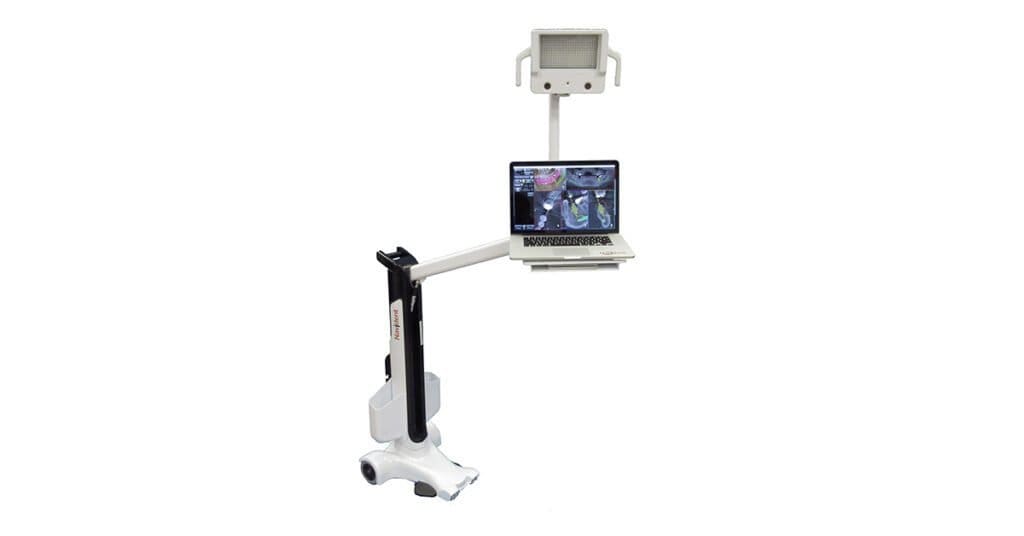
Navident 3 surgical navigation system
ClaroNav has released Navident 3, the 3rd generation of its dental surgery navigation system.
Navident is a solution in computer-aided dental surgery that offers dental practices a highly portable method to plan the desired restoration and implant placement on a virtual patient, then execute the plan on the real patient’s jaw.
Navident 3 is said to be able to guide the drilling for implant placement in “practically any jaw”, while reducing pre-surgical preparation time and procedure costs.
According to ClaroNav, they enable Navident to track jaw motions in a minimally intrusive manner.
“By widening its indications for use to include any patient with missing teeth, including the 10 per cent of US population that is missing all of their teeth. Jason Pardo Global VP of Sales and Marketing for ClaroNav “This clearance will make it even more compelling for American dental surgeons to integrate Navident into their daily workflow.”
Read more about Navident 3 surgical navigation system.

Brava AI Orthodontic Solution
Brava is an AI-driven teeth straightening solution based on the Brius Technology’s patented biomechanical back-of-the-teeth system.
The patient’s customized per-tooth treatment plan, which puts each tooth on an independent path to its final planned position, may be pre-programmed into Brava’s’ NiTi arms.
This can be done in partnership with a certified Brava orthodontist.
The NiTi arms are made from shape memory alloy – a material purportedly invented for the space program.
Brava’s Independent Mover technology ensures the movement of any tooth has little to no effect on its neighbouring tooth, thereby avoiding unwanted tooth movement and round-tripping – problems associated with traditional bracket and wore systems.
Brava is designed to treat all ranges of malocclusions, including simple to difficult cases in as little as four appointments.
Read more about Brava AI Orthodontic Solution.
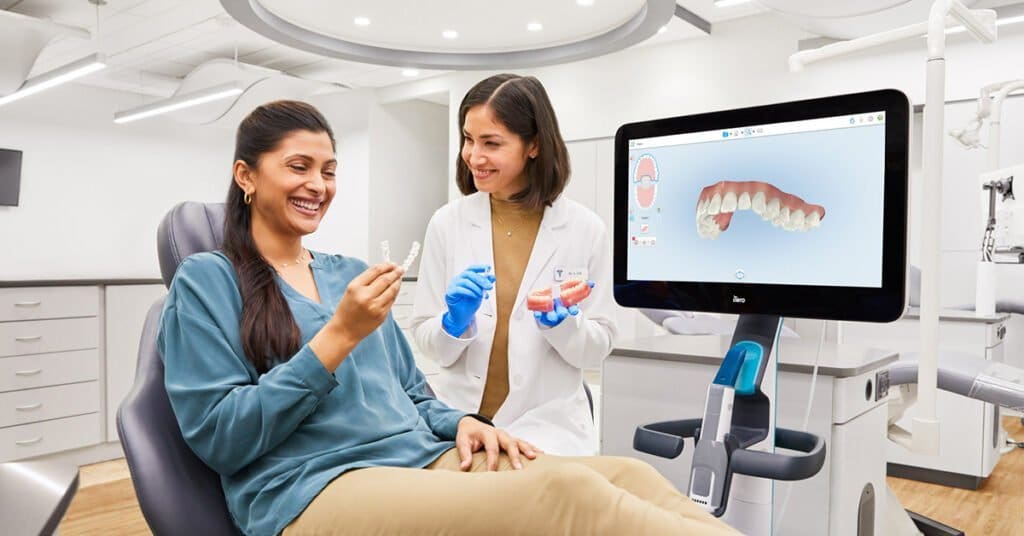
Imagine OPEN Go Digital Mill
Imagine OPEN Go Digital Mill is an open-technology digital dental solution for dental clinics.
It is said to provide dental clinics with a proven digital workflow from intraoral scanning through in-house milled restorations.
Supplying the hardware, software, and training needed for dentists to get started immediately, Go Digital Mill™ affords clinicians the ability to design and produce same-day crowns, bridges, inlays, onlays, veneers, provisionals, and custom abutments — all done in-house.
Imagine OPEN™ Go Digital Mill™ is designed for general and comprehensive dentists who aren’t yet benefitting from the open digital workflow or doctors who are but want to take it to the next level — Felix Chung Felix Chung, CEO at Imagine USA.
“It provides them with reliable and proven open CAD/CAM system that we have tested, perfected, and can quickly train them to use proficiently.
“Because our solution is based on all “open” technology, the CAD/CAM files can be used by anyone with an open digital system, which gives doctors tremendous flexibility to produce restorations and appliances in-clinic if they choose, send cases out to labs when they prefer — or do both.”
Imagine OPEN™ packages – even though Imagine OPEN is a completely scalable solution The solution also works with Align Technology’s iTero scanning technology, which the company says is at the heart of all.
Read more about Imagine OPEN Go Digital Mill.
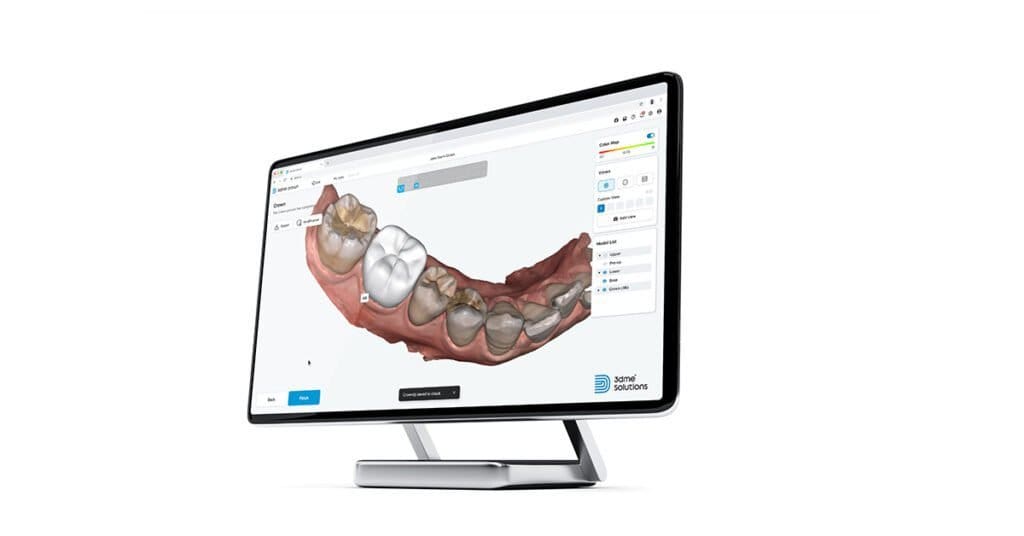
3Dme Crown AI Cloud software
Cloud-based and AI dental solutions provider Imagoworks has launched the 3Dme Crown software.
Launched as part of the company’s 3Dme Solutions suite, 3Dme Crown software uses AI to generate an ideal crown design automatically in less than a minute using the patient’s 3D scan data.
The software is said to be able to automatically identify the margin between the tooth and gingiva of the crown to be manufactured thereby suggesting an optimised margin. It is then able to create a crown design in just a few clicks – purportedly at a speed much faster than many existing dental CAD options on the market.
This crown design can be downloaded and sent to a 3D printer or milling machine for immediate production of the prosthesis.
Since the 3Dme Crown connects to the 3Dme Cloud data management platform, users can access the cloud-based solution without having to install a program.
Instead of generating the crown design based on an existing library of tooth images, the software’s AI suggests a crown design optimised for the patient’s oral environment through deep learning.
Read more about 3Dme Crown software.

XR Therapy VR app for pain relief
XR Therapy is an app from xCura that is designed to provide a comfortable experience for patients as they undergo treatment.
Strapped to the head of a patient, the VR headset, also known as VR goggles, allows the patient to be fully immersed in the 360-degree VR space.
XR Therapy has been used for major treatments and tests for pain and anxiety.
The app promotes relaxation for patients undergoing treatment by guiding the length and timing of breathing through VR images and by narrating autogenic training and progressive muscle relaxation.
The app works within the ‘Kiosk’ mode of the VR headset from HTC known as VIVE Flow.
According to xCura, patient feedback has been positive indicating a smooth treatment without vomiting reflex – a common issue with prolonged VR use.
Read more about XR Therapy VR app.
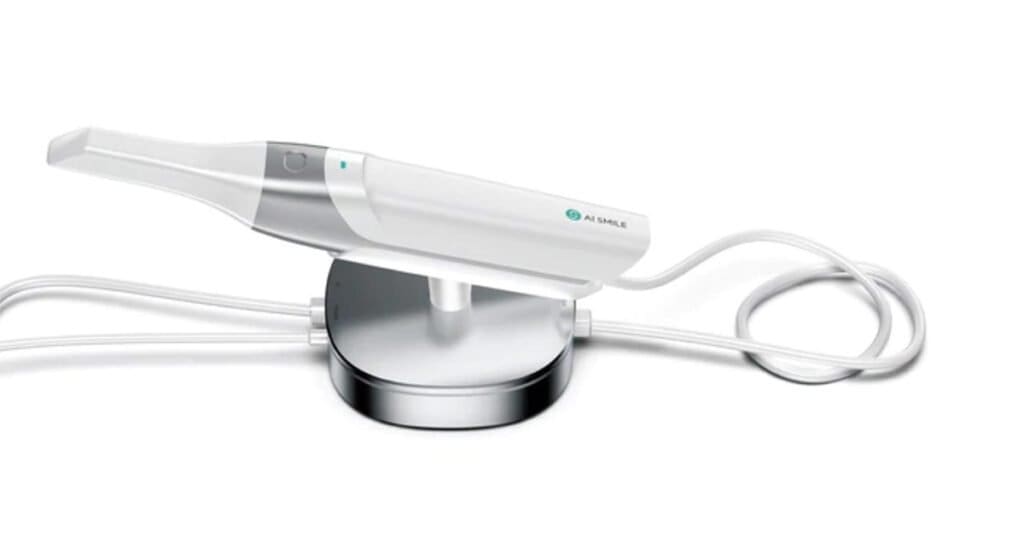
Weiyun’s AI Smile Intraoral scanner
Winner of Germany’s Red Dot Design Award, the AI Smile is the Intraoral scanner S4 from Weiyun AI & Robotics Group
The China-developed instrument can purportedly carry out precise (10um) point cloud grid imaging in two minutes.
Utilizing independently developed software, hardware and optical modules, the AI Smile is able to generate an orthodontic AI simulation solution in 10 minutes, and access 3D point cloud data and color texture information of the patients’ oral cavity with an accuracy of 10 microns.
As a portable high-precision handheld instrument, AI Smile is designed to obtain millions of cases and calculate strategies and processes through Cloud-based CAD/CAM. Connected to the Cloud, the AI device is able to access a global database of 1.2 million cases online.
Using AI Smile, the dentist can display the 3D customized treatment plan to the patient in real time, and adjust the plan according to prevailing clinical needs.
Once confirmed, the AI-powered “Smart Factory” then organizes and delivers the customized dental product within 48 hours.
Read more about Weiyun AI Smile.
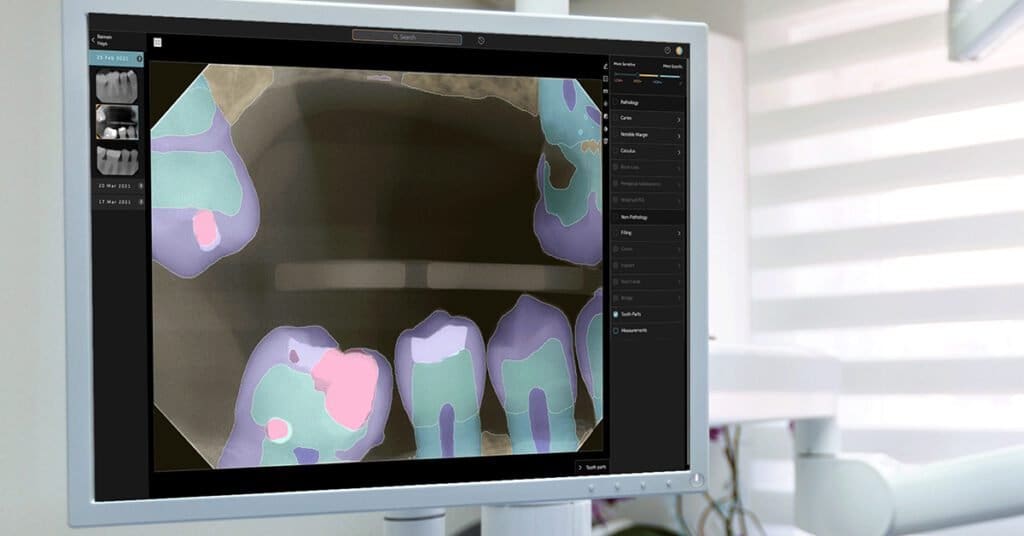
Pearl’s Second Opinion AI-powered radiologic detection aid
Second Opinion is a radiologic detection aid powered by artificial intelligence (AI).
It purportedly helps dentists identify a number of common dental conditions – including tooth decay, calculus, and root abscesses – in patient x-rays.
Pearl’s system applies computer vision to identify and highlight key pathologic and nonpathologic findings – including dental caries, discrepancies at the margin of existing restorations, calculus, periapical radiolucency, crowns, fillings, root canals, bridges and implants.
Second Opinion displays the x-ray images and any detected conditions on the monitor screens of the operatory, to facilitate AI-powered diagnostics and patient communication.
According to Pearl, Second Opinion exceeded the FDA’s efficacy requirements across four separate clinical studies. The tests found the AI-assisted readings accurately identified 36% more lesions than those without AI assistance, said the company.
Read more about Pearl’s Second Opinion AI-powered radiologic detection aid.
The information and viewpoints presented in the above news piece or article do not necessarily reflect the official stance or policy of Dental Resource Asia or the DRA Journal. While we strive to ensure the accuracy of our content, Dental Resource Asia (DRA) or DRA Journal cannot guarantee the constant correctness, comprehensiveness, or timeliness of all the information contained within this website or journal.
Please be aware that all product details, product specifications, and data on this website or journal may be modified without prior notice in order to enhance reliability, functionality, design, or for other reasons.
The content contributed by our bloggers or authors represents their personal opinions and is not intended to defame or discredit any religion, ethnic group, club, organisation, company, individual, or any entity or individual.

